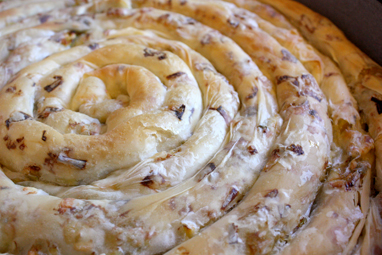Handmade Pastry with Leek and Feta (Tegnato Maznik so Pras i Sirenje)
So far I have already posted two maznik recipes, handmade maznik, and cheats maznik with filo pastry. This maznik recipe would have to fall somewhere in between. There’s no yeast required and the process of preparing each sheet is nowhere near as laborious as my mum’s.
This recipe comes from my mother-in-law, although she knows how to roll out each pastry sheet using a long thin rolling pin she prefers the process of stretching the sheets as it takes half the time.
The texture of pulled (tegnato) maznik is much drier and less bread-like, so I prefer it with wet fillings like a combination of leek and feta, or sweet versions with sugary grated pumpkin or apple.
……………………………………………………………………………………
Recipe
Makes 2 mazniks, serves 16
Ingredients
Filling
3-4 leeks, white and light green part chopped, dark green outer leaves discarded
3-4 tablespoons vegetable oil (e.g. canola or rice bran oil)
Sea salt to taste
400g feta cheese, coarsely grated
Dough
3 1/2 cups (440g) plain flour, sifted, plus extra for dusting
1/2 teaspoon sea salt
3 tablespoons (60ml) vegetable oil, plus extra for drizzling/brushing
1 1/2 cup (375ml) lukewarm water
You will need:
• Large bowl (for dough)
• Frying pan
• Medium bowl (for feta and leek filling)
• Cheese grater
• Large clean work bench/table
• 2 clean rectangular tablecloths (one for resting dough, the other for stretching and rolling)
• Rolling pin
• Plastic wrap (to cover resting dough)
• 2 large round trays (pizza trays work well)
Method
1) Heat oil in a large frying pan over low-medium heat, add leek and sprinkle with salt to taste, gently fry until leek has collapsed (7-10 minutes). Once cooked remove from heat, allow to cool and drain excess liquid.
2) In a large bowl add sifted flour and salt, make a well in the centre. Add oil and water, using one hand incorporate the wet and dry ingredients and scrunch to combine. Once combined (2-3 minutes) turn out to a flour dusted surface and knead. Continue to sprinkle with extra flour if the dough sticks and knead until smooth and elastic (7-10 minutes).
3) Divide dough into 8 equal portions (divide into 10 if you have limited bench space). Take one of the portions and knead into a smooth ball (1 minute), flatten with the palm of your hand and roll out to an even circle (15-20cm in diameter) and rest on a flour dusted tablecloth or tray which is out of the way, repeat with remaining dough. Brush the top of each dough circle with oil then cover with plastic wrap to avoid drying out and allow to rest for 30 minutes.
4) After 25 minutes grease 2 medium round trays with vegetable oil and preheat oven to 200°C.
5) Combine drained leek and feta cheese and set aside.
6) Place the other rectangular tablecloth on your workbench and generously dust with flour. Place the first rolled out circle on the tablecloth and generously dust the top. Using the palm of your hand press the dough to flatten out evenly (20-25cm in diameter), turnover and repeat on the reverse side to even out and stretch out a little more, flip over one last time, now roll out the edges further with a rolling pin (40-50cm in diameter). Dust both hands with flour, gently lift up the dough sheet, position your hands at the top with the pastry falling towards you, create loose fists with your hands so that your fingers don’t tear the pastry. Starting at the centre, use one fist/forearm to support the pastry and the other to gently lift, stretch and pull out (your fists should be facing inwards and approximately 30cm apart). You’ll need to work quickly, initially from the centre then gradually working your way to the edges as the centre will become too thin and tear, continue to gently pull away, stretch outwards and rotate the sheet until it becomes too large to manage (approximately 70cm). Now change your technique, position your hands at the top with the sheet falling in the middle, group your fingers together to gently support the dough, while your thumb gently holds and stretches the dough. The pastry will fall on the bench, continue strecthing and pulling the edges gently, avoiding the centre until approximately 80cm in size, layout on tablecloth. Using your thumb and forefingers gently pull and strecth out the edges even further until over a meter in size.
7) Drizzle the entire sheet with oil, then sprinkle filling, only over the middle section (the edges will most likely fall off the edge of your table/bench). Fold the pastry closest to you over 1/3 of the filling, then lift the tablecloth edge closest to you up and allow the pastry to roll away into a sausage, then pull the tablecloth back towards you and sprinkle some extra filling over the last 1/3 and continue to roll. Coil the pastry into a snail and place in the centre of your greased tray. Continue with the remaining dough and filling to fill both trays, you’ll need 4 rolls per tray.
8) Once you have a full tray of coils, drizzle the top generously with oil, particularly around the edges. Bake for 40 minutes, rotating the tray halfway through. Serve immediately or at room temperature with salad, yoghurt or buttermilk.
Tips:
– Maznik will keep refrigerated for up to 5 days or frozen for up to 3 months. Reheat in a warm oven before serving.
– Check out this video of an expert maznik maker












 are preserved and enjoyed
are preserved and enjoyed
Damacino Ancco Condo
muy bueno la tecnica pero me gustaria. que la receta fuera con gramos por la regularidad es como mi abuela que dice en tazas cucharadad pero los ingredientes son lo mismo. bunca esta igual